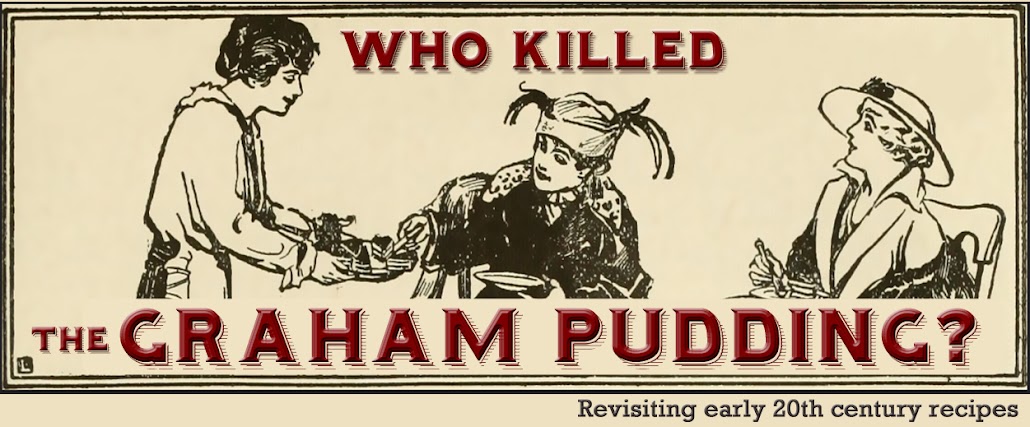We start, naturally, with Graham Pudding. The recipe I went with is from a 1914 cookbook called Things Mother Used to Make, by Lydia Maria Gurney.
| California Digital Library, Internet Book Archive |
As written:
Ingredients
1 1/2 cupfuls of graham flour
1/2 cupful of molasses
1/2 cupful of milk
1/4 cupful of butter
1 egg
1 teaspoon of soda
1/2 cupful of raisins and currants, mixed
salt and spice to taste
Instructions
Stir the soda into the molasses, then add the beaten egg and milk, salt and spice, and melted butter.
Add the flour and, last of all, currants and raisins, which have been sprinkled with flour.
Steam two hours in a tin pail set in a kettle of water and serve hot with sauce.
Ingredients
1 cupful of sugar
1/2 cupful of butter
1 egg
1 lemon
1/2 pint boiling water
Instructions
Cream together the butter and sugar.
Add the well-beaten yolk of egg.
Pour over this the boiling water, juice of lemon and well-beaten white of egg.
*
Most recipes out there agree on the basics of the pudding; the recommended sauces vary, with many including sherry and/or wine, which is probably also delicious.
The key, eponymous ingredient of the Graham Pudding is graham flour. I confess I had never heard of this, but my local, small grocery store had it in the Various Flours section so perhaps it's not as uncommon as I assumed.
 |
Graham Flour
(all photos by Anna)
|
Graham flour was the brainchild of Reverend Sylvester Graham, an early nineteenth century minister dedicated to diet reform, especially whole grains, vegetarianism, and bland food (the Graham Pudding would no doubt horrify him!). It's essentially a kind of coarse whole wheat flour, with the wheat kernel components ground separately then mixed. Now that I have a bunch of it, I shall also have to try out a recipe for graham bread, another of its staples--stay tuned!
But back to the pudding! The mixing of the ingredients, of course, is pretty simple. I used only raisins, rather than the mix of raisins and currants dictated, but I did sprinkle them with flour. For spice "to taste" I added pinches of allspice, cloves, and nutmeg.
 |
| The batter prepared |
To steam the pudding, the recipe instructs "two hours in a tin pail set in a kettle of water." Now, I don't have a tin pail nor any kind of water kettle that could be used in this way, so I cheated a little and searched for modern instructions on how to steam a pudding. Figuring Brits would know how to do this, I went with this guide from the BBC.
The gist of it is:
Put pudding batter into small metal bowl (I did not have one, so I took the handle off a small saucepan, which worked fine).
Take pieces of alumninum foil and buttered wax/parchment paper about the same size, crease, and place over the bowl, with the foil on top. Tie the foil around the bowl with string (I had no string so used several strings of thread and a big rubber band, which I do not recommend--use string!). Tuck the paper in and fold the foil tightly around it.
Take another piece of string and thread it through the string tied around both sides of the bowl, to make a handle.
 |
| Readying the pudding for steaming--with handle, but before tucking paper edges in |
Bring water to boil in a large saucepan (big enough to easily hold the bowl o'pudding). Most guides recommended putting a small saucer or trivet in the bottom for the bowl to rest on, but I didn't, which worked fine. When the bowl is put in the boiling water, the water level should reach about halfway up its sides; as it boils off, add water accordingly.
Steam for length of time recipe indicates. To test for doneness, stab a knife (or kebab stick, as I did) into the pudding; it should emerge dry.
--
I steamed my graham pudding like this for two hours, as the recipe stated, but found it needed another 45 minutes or so, for about 2 h 45 minutes total.
Once the pudding is done, invert it onto a plate. It is less than beautiful, but such is the lot of the pudding.
 |
| Newly steamed graham pudding |
The sauce should be made in the meantime. I made it exactly as written, including the important detail of seperating the egg and adding the yolk and whites separately. This allows the egg white to foam up nicely.
 |
| The sauce |
Since my pudding needed extra time to steam, I put my finished sauce in the fridge in the meantime and gave it another mix when the pudding was ready. Sadly this destroyed the foam, but not the taste. The sauce, quite simply, tastes amazing.
The pudding part on its own is certainly not untasty--a bit like a sweet molasses loaf.
 |
| Pudding, interior view |
But when you pour the sauce over it--and there is a lot of sauce, so you are required to be generous with it--and it soaks it up...!
 |
| Pudding is served! |
It may not ooze aesthetic appeal, but at first bite it's sure apparent why American ex-pats in London would miss it!
What is less apparent, however, is why on earth we stopped making this. It's simple (the steaming technique is perhaps unfamiliar to many North Americans these days, but it's not difficult), no unhealthier than any indulgent dessert, and delicious. Whoever killed it was a cold, cold person. Let us encourage its resurrection!
